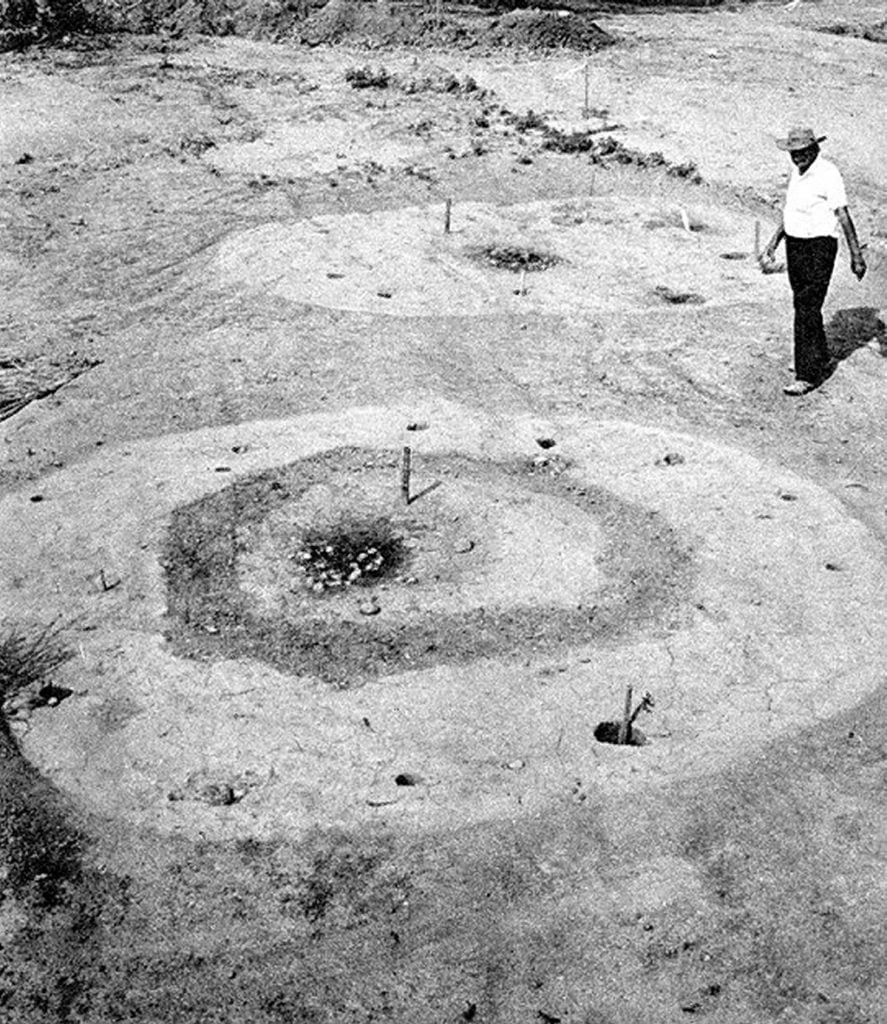Ocmulgee Bottoms is a corridor of the Ocmulgee River Flood Plain in the central region of the State of Georgia that begins at the Fall Line in Macon, GA and continues 38 miles southward to near Hawkinsville, GA. 1 This region is located in Bibb, Twiggs, Houston, Bleckley and Pulaski Counties. The Ocmulgee River’s velocity slows dramatically upon entering the Bottoms and has a serpentine channel. Over the eons, the river here has meandered frequently across the breath of the flood plain, leaving hundreds of ponds and swamps, plus a deep layer of rich, alluvial soil. On top of the alluvial soil is from one to ten feet or red clay that was deposited during the period when cotton was cultivated in the Piedmont, upstream.
Mankind has lived in the Ocmulgee Bottoms for at least 12,000 years. Clovis points have been found there. 2 The Fall Line Region and Bottoms provided a diverse ecological environment in which many natural sources of nutrition could be obtained by hunter-gatherers. The river provided a route for canoe transportation that extended from the Atlantic Ocean to the foothills of the Blue Ridge Mountains. The shoals blocked navigation by large trade canoes thus creating a portage landing that was a favorable site for a trading village. Major regional trade paths intersected at the original location of the portage site, even though the shoals continued to erode their way northward.

The roughly fifty square miles of rich alluvial soils in the Ocmulgee Bottoms made it an ideal location to adapt both indigenous plants and tropical cultivars from Mesoamerica and South America to a warm-temperate climate. Jerusalem artichokes, sunflowers, indigenous squash, indigenous amaranth and oily seed-bearing plants were probably being grown there as early as 3000 BC. Sweet potatoes and other root crops were probably introduced during the Middle Woodland Period (200 BC-600 AD.) 3
Cultivation of such Mesoamerican crops as maize, beans and members of the Mexican squash family were introduced intermittently during the Late Woodland and Early Mississippian Periods (600 AD-900 AD.) 4 Definitely, by around 900 AD, large scale agricultural activities were occurring in the Bottoms. This made possible rapid population growth. Villages and towns were spaced at regular intervals along the Bottoms. Most were on the edge of the flood plain, because the Ocmulgee was much more prone to flooding in the era before dams were built upstream. The acropolis on the Macon Plateau, overlooking the Ocmulgee River became one of the earliest centers of the Southeastern Ceremonial Cult.
Individual towns blossomed and faded in the period between 900 AD and 1805 AD, but Ocmulgee Bottoms was always a locale where indigenous populations were concentrated. These towns are associated with the Creek Indians. In fact, contemporary Creeks consider the Macon Plateau as the as the location where the Creek Confederacy was formed. 4
Citations:
- Calculation made by author using ERSI GIS software.[↩]
- Hally, David, Editor (1994) Ocmulgee Archaeology. Athens: University of Georgia Press; pp. 55-57.[↩]
- Dr. Arthur Kelly identified four varieties of feral sweet potatoes that looked like Morning Glories growing in the Chattahoochee River Valley, while excavating site 9Fu14 in 1969. The site was radiocarbon dated at 200 BC – 450 AD. The same styles of Woodland pottery were found at both 9Fu14 and Ocmulgee Bottoms – terminating with Swift Creek at the Chattahoochee River site.[↩]
- Riley, Thomas J. (1994) “Ocmulgee and the Question of Mississippian Agronomic Practices.” Hally, David, Editor (1994) Ocmulgee Archaeology. Athens: University of Georgia Press; pp. 96-204.[↩][↩]


